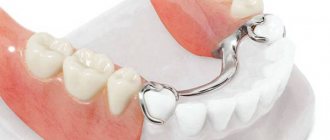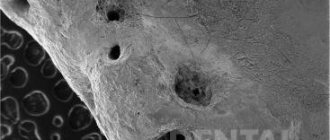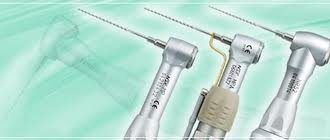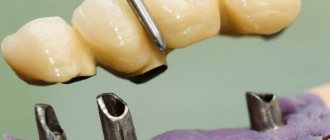Endodontic instruments Part 2
Profile Orifice Shapers (profile orifice shaper) - a set of tools made of nickel-titanium alloy with a blunt tip and a taper of 5-8%.
The tool comes in 6 diameters (1-6). The length of the cutting surface is 10 mm. Designed for processing the coronal part of the root canal. The advantage over Gates Gliden, used to widen the mouth of canals, is that, by expanding the coronal part to the first bend, it creates a transition in the form of a cone into deeper parts of the canal. Marked with 3 colored rings on the shank (Fig. 5-8). Profile O is available in 6 sizes 015, 020, 025, 030, 035, 040 with a working length of 21 and 25 mm. The length of the cutting surface is 16 mm, the working part is 21 and 25 mm. Marked with 2 colored rings on the shank.
Profile 04 is available in 9 sizes 015, 020. 025, 030, 035, 040, 045, 060, 090 with working lengths of 21, 25 and 31 mm. Designed for processing the apical part of the canal. Marked with 1 colored ring. In addition, the set includes profiles 08 and 015 for manual work.
Rice. 5-8. Profiles with increasing taper: orifice shaper, profile 06, profile 04, compared to profile 02
Profiles 04 and 06 are designed for handpiece operation at optimal speeds of up to 300 rpm.
Profiles have 4 features that distinguish them from other tools. First, they are made of nickel-titanium alloy, which gives them super-ductility, allowing them to process canals with bends of up to 90° (Fig. 5-9). Secondly, the profiles have a pronounced narrowing towards the top of the tool (Fig. 5-10). This allows you to use the tool more efficiently. A tool with a 2% taper, when penetrating the canal, comes into contact throughout its entire length with the wall (left), and a tool with a 4% or 6% taper, penetrating into the canal, comes into contact in a limited area (right) (Fig. 5-11).
Rice. 5-9. Superplasticity of the profile
Rice. 5-10. The shape of the root canal depending on the taper of the instrument (diagram). Figure 5-11. Borders of contacts between an instrument of increased taper and the walls of the root canal (diagram).
Rice. 5-12. Cross section of the profile. V-shaped side grooves (in the center), unlike other tools. ensures the removal of dentinal filings from the canal.
The third feature of the profiles is the U-shaped cross-section (Fig. 5-12) without pronounced cutting edges, which makes it possible to remove sawdust from the root canal. The fourth feature of the profile is the modified tip (blunt), which allows the tool to penetrate any curved canal.
A new direction in the creation of cutting endodontic instruments is to increase the taper, compared to the original ISO standard, by 2-6 times, i.e. instead of 2% - 4, 6, 8, 10 and 12%.
Greater Taper (GT) Rotary files (Figure 5-13). These new generation nickel-titanium endodontic instruments are perfectly adapted for root canal preparation using the Crown Down technique. Like Profiles, Greater Tapers are designed to operate in a clockwise rotating mode at 150-350 rpm using any suitable machine tip. These instruments are marked with gold-plated shanks.
Rice. 5-13. Greater Taper Set.
The set of rotating GTI files consists of 3 groups of tools.
The first group consists of 4 instruments with a taper of 12, 10, 08 and 06% with the same tip diameter 020 and lengths of 21 and 25 mm. This is the main group of instruments used for preparation using the Crown Down method. When preparing a canal, they first work with a file with a large taper and successively move on to an instrument with the smallest taper (6%).
The second group, also consisting of 4 instruments with a taper of 04%, tip diameters of 020, 025, 030 and 035 and lengths of 21, 25 and 31 mm, is intended for preparing the apical part of the canal. The smooth, flat outer edges of GI rotating U-shaped files prevent self-cutting of the instrument and ensure that the file is centered in the canal.
The third group consists of 3 instruments with a taper of 12%, tip diameters 035, 050 and 070 and lengths of 21 and 25 mm, they are intended for opening the canal orifices.
Using GI rotating files with different tapers, almost all root canals are successfully prepared. The largest size of the instrument tip (020 mm) and the maximum shaft diameter of 1 mm guarantee non-aggressive preparation of the apical part without disturbing the anatomy. As can be seen in the presented diagram (Fig. 5-14), each subsequent tool comes into contact with the channel wall only on a limited part of its length, which eliminates the possibility of jamming and, consequently, tool breakage.
Rice. 5-14. Root canal preparation using instruments with different tapers (diagram).
Tools should be cleaned after each use as cutting performance is reduced when the shank grooves are full. During preparation, abundant irrigation of the root canal is necessary.
I. Classification of endodontic instruments
⇐ PreviousPage 2 of 5Next ⇒| Classification of endodontic instruments | Tool type | Features of manufacturing the working part | Features of the operating mode. Required driving modes during operation | Area of use (application) |
| I. Instruments for expanding the root canal orifice | Gates Glidden | The working part is spear-shaped with a non-aggressive tip on a long shaft. Available in 6 sizes. | Used with a mechanical handpiece at low speeds -450-800 rpm | Expansion of the mouth and upper third of the canal |
| Largo ("Peeso Reamer") | The working part has an elongated shape with a non-aggressive tip on a long rod. Available in six sizes, which are marked with rings on the holder. | Used with a mechanical handpiece at low speeds - 700-1200 rpm | Expansion and passage of the ostial, upper and middle third of the straight canals of single-rooted teeth, as well as the palatal canal of the upper molars and the distal canal of the lower molars. | |
| Beutelrock Reamer B2(VDW) | The cylindrical working part is made of stainless chromium-nickel steel by twisting a flat blade having two cutting surfaces. The tool is very sharp. Has an active tip. | It is necessary to work only at low speeds | Used to prepare space for a pin structure. Expansion and passage of the mouth, upper and middle third of straight canals. Do not use for treating curved canals, because Possible perforation of the canal wall or fracture of the instrument due to lack of necessary flexibility. | |
| Beutelrock Reamer B1(VDW) | The working part is machined from a solid workpiece like a steel bur, has a sling-shaped shape with four cutting edges, each tapering towards the top of the tool. The tip of the tool is non-aggressive | Rotation speed in the contra-angle handpiece 800-1200 rpm | It is used to create and expand access only in the direct part of the channel, because the tool is not flexible | |
| Orifice Opener | Has a tetrahedral working part, tapering towards the apex | Hand tool | To widen the ostial third of the root canal with smaller instruments. | |
| ProFile Orifice Shapers (profiles for opening the mouths of root canals) | Made of nickel titanium alloy. The length of the working part is 19mm. Available in 6 sizes: 1 (05/20) 2 (06/30) 3 (06/40) 4 (07/50) 5 (08/60) 6 (08/80). The numbers 05.06, 07.08 indicate the taper of the tool, and 20, 30, 40, 50, 60. 80 is the ISO tip diameter. This series of profiles has 3 rings on the shank, the color of which indicates the size of the tool tip | Used with a special endodontic handpiece with high torque and controlled speed. The optimal rotation speed is 200-300 rpm.' | Allows you to create a cone-shaped shape of the canal mouth, eliminate existing overhangs and narrowings, and also facilitate penetration into the depths of the canal | |
| II. Root canal instrument | K - Reamer (Kerr's drill) | The tool is made of stainless steel by twisting, has an extended pitch of the cutting edge (spiral), due to which high flexibility and cutting ability are achieved. Small size K-reamers (up to No. 40) are made from square wire, resulting in increased fracture resistance. They have a non-aggressive top. Large size K-reamers (from No. 45) are made of triangular wire, which gives the tool the necessary flexibility and high cutting ability. They have an active cutting tip. | When working with hand-held K-reamers, it is necessary to make movements similar to those when winding a watch. The maximum rotation angle is 180°. | Primary probing of the root canal and its passage. Determination of the primary length and possible curvatures of the canal |
| K-Flexoreamer | The tool has great flexibility, which is associated with a decrease in the spiral pitch as a result of twisting. In addition, K-Flexoreamer is made from triangular wire | Movements during operation as when winding a watch | For passage of thin and curved canals. | |
| K-Flexoreamer golden medium (meillefer) | Represents “K-Flexoreamer” tools of intermediate sizes - №№12, 17,22,27,32,37 | Movements when working are like winding a watch. | Used when it is difficult to pass from one standard tool size to another. For example, if it is difficult to insert “K-Flexoreamer” No. 25 after “K-Flexoreamer” No. 20, an intermediate instrument “K-FIexoreamer golden medium” No. 22 should be used. | |
| K - Reamer Forside | A set of K-reamers with a working part of short length 15-18 mm and diameter 06, 08, 10, 15 | Movements during operation as when winding a watch | For passing very thin canals, especially molars with difficulty opening the mouth. | |
| K - Reamer Deepstar | A set of shortened K-reamers in sizes from #20 to #60 with a sharp tip and two Orifice openers | Movements during operation as when winding a watch | Designed for unsealing root canals, especially molars with difficulty opening the mouth. | |
| III. Tools for Extending Root Canal Alignment | K-File(Kerra Drill) | The tool differs from the K-reamer in its greater flexibility, which is associated with a smaller spiral pitch. K-File of small sizes (up to No. 25) is made from square wire, which reduces the likelihood of the tool breaking and untwisting. K-File with No. 30 is made from triangular cross-section blanks, which increases their flexibility and cutting ability K-File starting from No. 70 has an active, sharp tip | When working with K-files, it is necessary to perform both reciprocating movements and movements similar to those when winding a watch a quarter turn in one direction or the other. | It is a universal instrument and can be used for simultaneous passage and expansion of root canals |
| K-flexofile | It differs from the K-file in greater flexibility, which is achieved by an even greater reduction in the pitch of the spirals. In addition, all K-flexofiles are manufactured from triangular cross-section blanks, which reduces the overall cross-sectional area of the tools | The movements are the same as when working with K-file | Used to treat and clean heavily curved canals | |
| K-flexofile golden medium | Represents K-flexofile tools of intermediate sizes – No. 12,17,22,27,32,37 | The movements are the same as when working with K-file | Allows you to facilitate a smooth transition from one tool size to the next | |
| File Nitiflex | The tools are produced by turning and are made of nickel-titanium alloy, therefore they are highly flexible and elastic. When removed from a curved canal, the instrument straightens, taking its original flat shape. Nitiflex has a non-aggressive tip. | During operation, only reciprocating movements and movements of a quarter turn in one direction or the other are permissible. | Used for very curved (up to 90 degrees) and thin root canals | |
| Hedstroem file | Features high cutting ability. Made from a round steel blank on which spiral cutting edges are machined | During operation, only reciprocating movements are allowed, because If you try to rotate the tool along the axis, the tool may break off in the channel. The selected Hedstroem file must be 1 size smaller than the previously used K-file: after K-file No. 20, Hedstroem file No. 15 should be used | Designed to align the walls of the root canal, especially if the cross-section is pear-shaped or oval. | |
| Rasp (rasp) | The working part is a round cone-shaped rod, which is spirally surrounded by 50 sharp small teeth located at right angles to the axis of the tool. The size of the teeth is ⅓ of the diameter of the rod. The teeth are very strong and do not bend when inserting and removing the instrument from the canal. | It is recommended to use sawing and rotating movements. Next, the walls must be aligned with K-file and Hedstroem file. | Used to widen the root canal and remove soft contents from it | |
| Profile system | Made of ultra-flexible nickel-titanium alloy (titanium-46%, nickel-54%) which has the property of returning to its original position and shape after removing the load. The U-shaped flat shape of the edges and the cone-shaped non-aggressive tip allow you to 1) Keep the instrument in the center of even a strongly curved canal 2) Eliminate the possibility of the instrument jamming in the canal 3) Prevent the possibility of perforations and the creation of ledges in the dentin of the root 4) Allows you to evacuate the contents of the canal (remains of pulp, dentine filings) along the central shaft towards the orifice. A special feature of Profile is the constant increase in the diameter of the tip of each subsequent instrument by 29%, which gives the effect of a uniform increase in the diameter of the root canal. Profile comes in 4% taper and 6% Profile have a non-aggressive tapered tip. | Used with a special endodontic handpiece with high torque and controlled low speed. The optimal rotation speed is 200-300 rpm. | Allows the preparation of highly curved canals, creating a cone-shaped shape and without changing the natural direction of the root canal | |
| GT Rotary Files (Maillefer) | Made of nickel-titanium alloy, unlike Profile, it is available with a taper of 12%, 10%, 8%, 6% and the same tip diameter - 0.20 mm. Moreover, the greater the taper of the tool, the shorter the working part | Just like Profile, it is used with a lowering endodontic handpiece at a speed of 200-350 rpm. File rotates clockwise 360 degrees in the tip | Designed for preparation of highly curved canals using the Crown down technique | |
| IV. Tools for removing soft root canal contents | Pulpextractor | This is a toothed tool, the working part of which has about 40 teeth, located in different planes at an angle to the tool handle and with slight mobility. The tool is intended for one-time use | The pulp extractor is inserted into the root canal to the required depth, rotated ¼-½ turn (carefully) and removed along with its contents. The tool is very fragile | Used to remove pulp or necrotic tissue from the root canal. When inserted into the canal, the teeth of the pulp extractor are pressed against the rod, facilitating the advancement of the instrument in the canal. When the instrument is removed from the canal, the teeth straighten, capturing the pulp tissue and completely removing it. |
| K-File | see above | see above | These instruments are effective for removing not only pulp tissue from the canal, but also softened, infected dentin | |
| Hedstroe File | see above | see above | ||
| ProFile | see above | see above | ||
| GT Rotary Files | see above | see above | ||
| V. Instruments for filling root canals | Lentulo (Channel filler) | They are a conical spiral, available in four sizes No. 1 (red ring on the holder) No. 2 (blue ring) No. 3 (green ring) No. 4 (black ring) There are 2 types of channel fillers - manual and machine | The optimal speed when working with machine channel filler is 100-200 rpm. When rotating, paste or sealant is injected into the channel | For introducing endodontic pastes and root sealants into the canal. |
| Spreader (side seal) | This is a hand-held cone-shaped instrument with a smooth round rod. They are made of stainless steel or nickel-titanium alloy and have a pointed tip. The dimensions of the spreaders correspond to the dimensions of the instruments for mechanical canal preparation, as well as the diameter of the gutta-percha pins | Insert vertically into the canal between the gutta-percha pin and the wall of the root canal until it stops and perform circular compacting movements | Designed to seal gutta-percha pins during lateral condensation | |
| Plugger (vertical seal) | This is a cone-shaped or cylindrical smooth instrument of round cross-section, having a flattened plug-shaped top | Vertical condensing movements | Designed for vertical condensation of gutta-percha in the root canal | |
| Gutta-condenser | A tool made of stainless steel with spiral-shaped edges facing towards the top of the tool. | Use with contra-angle handpiece at speeds from 8,000 to 20,000 rpm. | Designed for thermomechanical condensation of gutta-percha in the canal |
II. Standardization according to ISO.
The sizes of endodontic instruments are standardized according to the recommendations of the International Organization for Standardization. Color coding makes it easier to find the right tool diameter. After the three smallest sizes, No. 6 pink, No. 8 gray
and No. 10 purple, the color sequence white, yellow, red, blue, green, black is repeated three times.
Right: Tool length according to ISO is 16 mm.
There are three tool diameters: d1 - at the top, d2 - at the beginning of the cutting part (the distance from d2 to the top of the tool is 16 mm)
and d3 - at a distance of 3 mm from the apex.
III. Methods for determining the working length of a tooth
| Method name | Execution method | Self-control criteria |
| Estimated length of tooth and root according to the table | The rubber stop located on the endodontic instrument is set to a mark corresponding to the average size of the estimated length of the tooth being treated. A K-reamer or K-file with a stopper installed is inserted into the root canal until it stops | If, after inserting the K-reamer or K-file into the canal all the way, the limiter reaches the cutting edge or chewing surface of the tooth, then the tip of the instrument is within the apical constriction. With partial passage of the root canal, the stopper does not reach the tooth surface by more than 2 mm, which indicates the need for further passage. However, it should be remembered that deviations of up to 2 mm upward or downward may be associated with individual fluctuations in the size of the tooth of a given group. This method of determining the working length of a tooth must be confirmed by x-ray or electrometric methods and only in the absence of the above methods can be considered as independent. |
| Method based on the patient's subjective feelings | It is carried out during dental treatment without anesthesia, when there are no destructive changes in the area of the root apex. | When removing the instrument beyond the apex of the tooth root, the patient usually feels a slight prick. This method can be used to determine only the approximate length of the tooth. After the patient develops a slight pricking sensation, the instrument should be “pulled” out of the canal by 0.5 mm or 4 turns counterclockwise and an X-ray or electrometric measurement should be taken. |
| X-ray method | An endodontic instrument with a rubber stop, which is installed at a mark corresponding to the average length of the tooth, is inserted into the root canal until it stops and a diagnostic radiograph is taken. The instrument is chosen to be small in size so that it fits freely into the canal without resistance or friction against the walls. | On the radiograph, the tip of the instrument should be located in the area of the radiological apex of the root or at a distance of 0.5-1.0 mm from it. However, it should be remembered that the radiological apex of the root does not always correspond to the anatomical, much less the “physiological” apex of the root. If the root is curved or the anatomical foramen is located on the lateral surface of the root, the root will appear slightly longer on the radiograph. In this case, the X-ray examination data must be supplemented with indications from the electrometric method for determining the working length of the tooth. |
| Electrometric method | The tool for passing the root canal K-Reamer or K-file is inserted into the tooth canal until it stops (within the average length of the tooth). Then one of the electrodes (passive) is placed on the mucous membrane of the vestibule of the oral cavity or cheek, and the other electrode (active) is attached to the metal part of the instrument. The circuit closes | If the sound signal does not appear, it means that the instrument has not reached the top of the root and is being pushed deeper. If an audio, digital or light signal occurs, then the channel has been passed to the top. When the instrument is moved beyond the apex into the periodontal tissue, various types of apex locators trigger an error signal, expressed in the form of a red light coming on, the appearance of a long loud sound signal, etc. It is important to note that the accuracy of determining the position of the apical foramen using the electrometric method ranges from 60 to 97% in depending on the apex locator design and measurement conditions. Therefore, this method in some cases should be used in conjunction with the x-ray method of examination. |
⇐ Previous2Next ⇒









